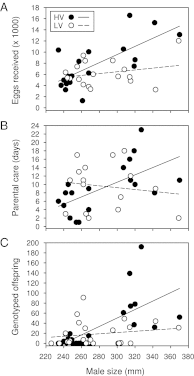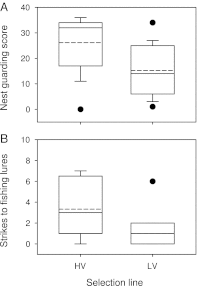Recreational fishing selectively captures individuals with the highest fitness potential
- PMID: 23213220
- PMCID: PMC3529059
- DOI: 10.1073/pnas.1212536109
Recreational fishing selectively captures individuals with the highest fitness potential
Abstract
Fisheries-induced evolution and its impact on the productivity of exploited fish stocks remains a highly contested research topic in applied fish evolution and fisheries science. Although many quantitative models assume that larger, more fecund fish are preferentially removed by fishing, there is no empirical evidence describing the relationship between vulnerability to capture and individual reproductive fitness in the wild. Using males from two lines of largemouth bass (Micropterus salmoides) selectively bred over three generations for either high (HV) or low (LV) vulnerability to angling as a model system, we show that the trait "vulnerability to angling" positively correlates with aggression, intensity of parental care, and reproductive fitness. The difference in reproductive fitness between HV and LV fish was particularly evident among larger males, which are also the preferred mating partners of females. Our study constitutes experimental evidence that recreational angling selectively captures individuals with the highest potential for reproductive fitness. Our study further suggests that selective removal of the fittest individuals likely occurs in many fisheries that target species engaged in parental care. As a result, depending on the ecological context, angling-induced selection may have negative consequences for recruitment within wild populations of largemouth bass and possibly other exploited species in which behavioral patterns that determine fitness, such as aggression or parental care, also affect their vulnerability to fishing gear.
Conflict of interest statement
The authors declare no conflict of interest.
Figures


References
-
- Jørgensen C, et al. Managing evolving fish stocks. Science. 2007;318(5854):1247–1248. - PubMed
-
- Kuparinen A, Merilä J. Detecting and managing fisheries-induced evolution. Trends Ecol Evol. 2007;22(12):652–659. - PubMed
-
- Heino M, Godø OR. Fisheries-induced selection pressures in the context of sustainable fisheries. Bull Mar Sci. 2002;70(2):639–656.
Publication types
MeSH terms
LinkOut - more resources
Full Text Sources
Research Materials

